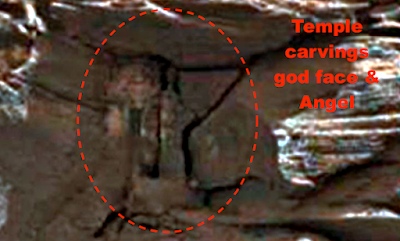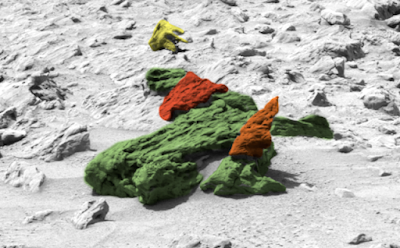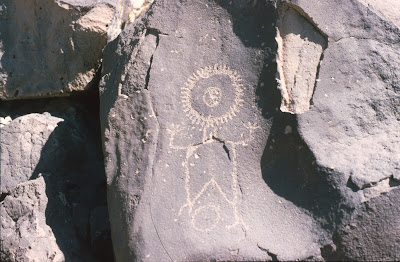Itacoatiaras of Inga, of the State of Paraiba, Brazil. Online photograph, public domain.
Some places
or features seem relatively mundane and are often taken for granted, others are
so striking that they attract a whole lot of attention, especially from
fringies and their bizarre theories. The Itacoatiaras of Inga, of the State of
Paraiba, Brazil, is a striking petroglyph panel that has been interpreted as
everything from a remnant of Atlantis and a Phoenician inscription to an Archaeoastronomy
site, and it is obviously none of these. Once again, the racist assumption that
the poor, benighted, ignorant savages native to the area could never have
performed such a feat colors the interpretation of rock art.
Itacoatiaras of Inga, of the State of Paraiba, Brazil. Online photograph, public domain.
An example
of the nonsense which has been attached to this poor rock is this statement. “According to Gabriele Baraldi,
archaeologist, epigraphist, and Italian-Brazilian alternative researcher, known
as the ‘last atlantologist’, American proto-Hittite(s) controlled geothermal
energy and apparently did hieroglyphics with (a) mold by applying high
mechanical and thermal stress on the rock from the lava conduit of an extinct
volcano.” (Sutherland 2015)
Itacoatiaras of Inga, of the State of Paraiba, Brazil. Online photograph, public domain.
This bizarre
and fringie concept would have us believe that rock and the petroglyphs on its
surface are cast from some sort of liquid (Faris 2021), in this particular
instance Baraldi is melting the Inga stone surface with heat from a lava flow
and pressing or molding the petroglyphs into the surface – that should cause a
blister or two. This concept is known as fluidics.
Itacoatiaras of Inga, of the State of Paraiba, Brazil. Online photograph, public domain.
Another description
of the Inga Stone is found in Costa (2020). “The
stone was also studied by Gabriele D’Annunzio Baraldi, who discovered, in
addition to archaeoastronomic patterns, signs of Hittite writing, developed and
used in Turkey in mid 2000 BC. Archeoastronomy studies the astronomical
knowledge of prehistoric man. Their patterns are identified and determined by
observing the alignments of the start and the planets in relation to the
structures and figures erected by man. By constructing their monuments in this
way, humans would be able to observe and predict the climatic seasons of the
equinoxes and consequently prepare themselves to plant or reserve the foods
that would serve their needs during difficult times, although it is necessary
that hunters pastors (who were officially supposed to live at that time) would
have neither the time or the knowledge to do so, not to mention the fact that
they are always changing and therefore unable to devote themselves to such
specific matters, require of them a place to residence. That is, in order to
determine the stone marking of a given astronomical phenomenon and its
representation, it would be necessary for these people to remain in place
during the seasons, and thus, as a consequence, to devote themselves to illustrate
a pattern.” (Costa 2020) In this somewhat hard to understand passage I am
guessing that the phrase “hunters pastors” that Costa used is meant to refer in
some way to hunter gatherer and pastoral cultures. So now we have added
archaeoastronomy and Hittite inscriptions to fluidics.

Itacoatiaras of Inga, of the State of Paraiba, Brazil. Online photograph, public domain.
And again, “later, F. Pavia continued the study of the
Inga rock, focusing this time on the recording of a series of signs inscribed
on the rocky surface of the channel itself, where a great number of ‘stars’ can
be observed that can be grouped into ‘constellations.’ Both the ‘capsular’ and
the ‘constellation’ records, in themselves, give Inga importance, which is why
many authors refer to the Inga Stone as one of the most underappreciated
monuments on the surface of Earth.” (Ancient Code Team undated)
Posseble floral motifs. Itacoatiaras of Inga, of the State of Paraiba, Brazil. Online photograph, public domain.
So let us
put the nonsense away and look at the reality of it. “The term ‘itacoatiara’ originates from the Tupi-Guarani language and
means ‘writing or drawing on stone’, having been used in Brazil as a synonym
for ‘rock engraving’ expressions. The rock art site of the Itacoatiaras of the
Inga River is located in the rural municipality of Inga, whose main city is
about 105 km from the city of João Pessoa, the state capital of Paraibe,
Brazil.” (UNESCO 2015)
Itacoatiaras of Inga, of the State of Paraiba, Brazil. Online photograph, public domain.
“Pedro do Inga (Stone of Inga) forms a wall
oriented in the northeast/southeast at about 24 m long and 3.5 m high, at its
highest point, and features the three main rock art panels at the site.” (UNESCO 2015) The images are carved
into its granite surface. “Most glyphs
represent animals, fruits, humans, constellations, and other unrecognizable
images.” (Wikipedia) Many seem to represent flowers or the buds of
herbaceous plants. What strikes me about them is the depth of carving (granite
has a hardness of 6 – 8 on the Moh’s hardness scale).
Aside from
the fringie/crackpot ideas I have been unable to find much real information
about this marvelous site. I see no possible evidence of the "star map" or any of the other strange ideas so far proposed. The best is report I could find is probably the UNESCO contribution and it is pretty sparse. I hope
that this site will be seriously studied and recorded for all of us.
NOTE: Some images in this
posting were retrieved from the internet with a search for public domain
photographs. If any of these images are not intended to be public domain, I
apologize, and will happily provide the picture credits if the owner will
contact me with them. For further information on these reports you should read
the original reports at the sites listed below.
REFERENCES:
Ancient Code Team, undated, Written in Stone: The Inga Stone – an ancient monument depicting a rare
“Star Map,” https://www.ancient-code.com. Accessed
online on 11 November 2022.
Costa, Telma, 2020, The Language of Inga Stone – A New Theory About the Origen of
Phoenician Alphabet – Itacotiara/Brazil, Oxford University History Society,
found on Academia.edu. Accessed 30 November 2022.
Faris, Peter, 2021, Fluidics? – The Dolmen of the North-West Caucacus and the Bizarre
Reports About Casting Stones and Rock Art From Liquids, 23 October 2021,
https://rockartblog.blogspot.com/search/label/fluidics.
Sutherland, A., 2015, Unsolved Enigma Of The Inga Stone And Its Mysterious Ancient
Undeciphered Signs, 18 January 2015, AncientPages.com. Accessed online on
17 October 2022.
UNESCO, 2015, Itacoatiaras of Inga River, 30 January 2015, https://whc.unesco.org/en/tentativelists/6000/.
Accessed online 12 October 2022.
Wikipedia, Inga Stone, https://en.wikipedia.org/wiki/Inga_Stone.
Accessed online on 29 November 2022.
















.jpg)






















